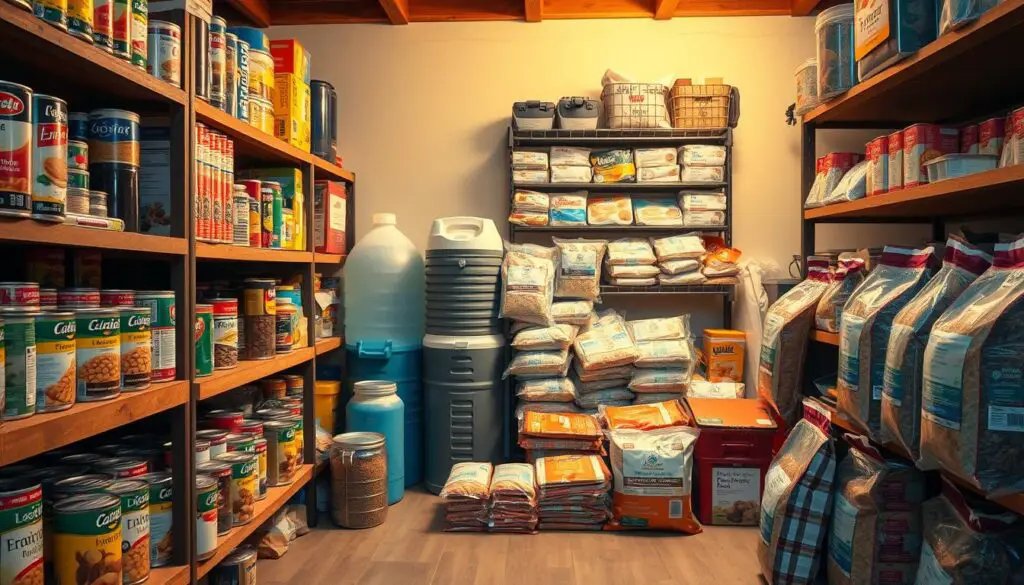Imagine having peace of mind knowing your family is ready for whatever life brings. For generations, self-reliance has been a cornerstone of communities prioritizing preparedness. This practice isn’t just about stockpiling—it’s about creating security through intentional planning.
Rooted in early teachings, leaders like President Spencer W. Kimball emphasized the importance of building reserves. In The Miracle of Forgiveness, he encouraged individuals to take responsibility for their needs. Pioneers in the 1800s stored essentials like wheat and flour for cross-country journeys, laying the groundwork for today’s strategies.
Modern methods blend tradition with practicality. Staples such as rice, beans, and powdered milk remain vital, but innovations like airtight buckets and shelf-stable goods simplify long-term storage. Church initiatives have evolved, too, focusing on gradual steps—like starting with a three-month supply—to make preparedness accessible.
This article explores how historical wisdom meets modern solutions. You’ll learn practical steps to build a tailored plan, discover budget-friendly tips, and understand why proactive habits matter now more than ever. Let’s turn foresight into action.
Key Takeaways
- Self-reliance traditions date back to early pioneer practices and teachings from church leaders.
- Staples like wheat, rice, and beans form the foundation of a resilient supply.
- Modern storage solutions prioritize convenience and long-term shelf life.
- Starting small—even with a week’s worth of supplies—builds confidence over time.
- Proactive planning helps families adapt to emergencies, inflation, or unexpected challenges.
The History and Principles of Mormon Food Storage
Long before modern supermarkets, communities faced harsh winters and uncertain harvests. This reality shaped early practices of preserving essentials—a tradition that became deeply rooted in collective wisdom.
A Legacy of Preparedness and Self-Reliance
Pioneers in the 1840s packed wagons with flour, dried beans, and salt to survive cross-continent journeys. These efforts laid the groundwork for organized home reserves. Deseret News archives reveal how families stored grains in wooden barrels, treating their pantries like sacred spaces.
By the 1930s, church leaders encouraged members to stock one year’s worth of staples like wheat and powdered milk. Cold War tensions later shifted guidance to two-year supplies, emphasizing readiness for global uncertainties.
Evolving Church Counsel on Emergency Supplies
Elder Tom Perry noted in 2007, “Practicality must balance tradition.” Modern advice focuses on three-month rotating supplies alongside financial reserves. Instead of bulk wheat, many now prioritize ready-to-eat goods and water storage.
This adaptive approach respects historical values while addressing today’s challenges. Whether storing rice in airtight buckets or learning preservation techniques, the core principle remains: thoughtful preparation fosters resilience.
Practical Steps to Build Your Emergency Food Storage
Creating a reliable reserve begins with simple math. Start by calculating your household’s daily calorie needs, then multiply by 7 to create a weekly plan. Expand this to 90 days for a functional three-month supply. Rotating items like canned vegetables or pasta ensures freshness while maintaining readiness.

Creating a Functional Three-Month Supply
Focus on meals your family already enjoys. For a household of four, aim for:
- 24 lbs of rice (½ cup daily)
- 18 lbs of beans (⅓ cup daily)
- 12 cans of vegetables (1 can weekly)
Store these in airtight containers labeled with expiration dates. Track usage with a pantry whiteboard.
Building a Long-Term Reserve
Complement short-term items with decade-lasting staples:
| Short-Term (1-2 years) | Long-Term (25+ years) |
|---|---|
| Dehydrated fruits | Hard white wheat |
| Rolled oats | Freeze-dried carrots |
| Powdered milk | Nitrogen-packed rice |
Incorporating Everyday Staples
Blend practicality with preparedness. Keep extra peanut butter for sandwiches and emergencies. Store baking soda for cooking and cleaning. One member shared: “We use our reserve weekly—it’s our grocery backup, not just for disasters.”
Update quantities every 6 months. Match your stockpile to seasonal recipes to maintain variety. This approach turns preparedness from a chore into a lifestyle.
Mormon Food Storage Techniques for Today’s Families
Balancing modern needs with time-tested methods creates a sustainable approach to household readiness. Today’s families benefit from both traditional wisdom and innovative resources available in their communities.
Selecting Quality, Shelf-Stable Ingredients
Prioritize items with low moisture content and nitrogen-packed sealing. Look for #10 cans of rice or beans, which resist pests and oxidation. Non-fat milk in foil-lined pouches retains freshness for up to 20 years when stored properly.
Check labels for expiration dates and processing methods. Whole grains like wheat last decades, while ground flour stays fresh only 2-5 years. Dehydrated carrots and other vegetables typically maintain quality for 15-20 years in ideal conditions.
Utilizing Local Food Storage Centers Effectively
Community centers offer significant savings—a #10 can of powdered milk costs $6.95 versus $20+ at commercial retailers. Volunteer-staffed locations keep prices low, with many items costing 60% less than survival brand equivalents.
These facilities welcome everyone, regardless of affiliation. One parent shared: “We saved $300 on our initial supply by purchasing oats and honey locally.” Most centers provide online ordering with flat-rate shipping, making bulk buying accessible nationwide.
Rotate newer purchases behind existing stock and label containers clearly. Pair long-lasting staples with weekly meal ingredients to maintain a functional, budget-friendly system.
Optimizing Your Emergency Preparedness Routine
A well-oiled preparedness routine turns anxiety into action. By aligning practical habits with timeless principles, families create systems that endure life’s surprises. Start by pairing quarterly check-ins with seasonal changes—spring cleaning or back-to-school weeks work perfectly.

Maintaining and Rotating Your Food Supplies
Mark calendars every April and October—aligning with general conference weekends—to refresh reserves. Swap older canned goods to the front of shelves and donate soon-to-expire items. One parent shared: “We treat rotation like a game—kids earn points for spotting near-expiration dates!”
| Check Every 3 Months | Check Every 6 Months |
|---|---|
| 72-hour kit snacks | First aid supplies |
| Battery expiration dates | Emergency blankets |
| Water purification tablets | Financial document copies |
Integrating Financial Reserves and Other Essentials
Build a three-layer safety net:
- 72-hour cash stash in small bills
- 3-month emergency fund
- Long-term savings account
Store communication devices in waterproof bags alongside kits. Update emergency contacts during daylight saving time changes. As church teachings remind us: “Readiness isn’t a project—it’s a pattern.”
“Test your kit during a weekend camping trip. You’ll quickly see what’s missing.”
Sync supply reviews with school breaks or tax seasons. This ties preparedness to existing routines, making it sustainable rather than stressful.
Conclusion
Building security through preparation has transformed over generations. What began with pioneers preserving grains in wooden barrels now thrives as adaptable household planning. Communities today blend time-tested wisdom with innovations like vacuum-sealed rice and community bulk purchasing.
Proactive habits remain central to success. Start small—even a week’s worth of essentials builds confidence. Gradually expand to three-month rotating supplies and decade-lasting staples like freeze-dried vegetables. Pair these with financial reserves for layered protection.
Local centers simplify the process, offering affordable bulk goods and expert guidance. Regular check-ins keep systems functional—swap older canned items during seasonal cleanouts or school breaks. As needs evolve, so do recommendations, balancing practicality with core principles.
Every step taken today strengthens tomorrow’s stability. Whether organizing pantry shelves or attending workshops, consistency matters most. With thoughtful effort, families create resilience that weathers storms—literal and figurative—while nurturing peace of mind.
FAQ
Why do members of The Church of Jesus Christ of Latter-day Saints emphasize emergency preparedness?
Church teachings encourage self-reliance to navigate unexpected challenges, from natural disasters to financial hardships. Building reserves helps families stay secure and assist others during crises.
How do I start a three-month supply of everyday essentials?
Begin by tracking meals your family regularly eats. Gradually stockpile non-perishable versions of those items, like canned vegetables, pasta, or oatmeal. Rotate products to maintain freshness and avoid waste.
What shelf-stable items work best for long-term reserves?
Staples like hard red wheat, white rice, dried beans, and freeze-dried fruits retain nutrients for decades when stored properly in airtight containers. Powdered milk and honey are also popular choices for extended shelf life.
Can I build reserves on a tight budget?
Yes! Many members add one or two extra items to grocery trips, like bulk rice or canned goods. Local food storage centers often offer discounted prices on basics like oats or sugar for community members.
How often should I update my emergency supplies?
Check expiration dates every 6 months. Use and replace items nearing their shelf life, integrating them into daily meals. This practice keeps your stock functional and reduces unnecessary spending.
Are financial reserves part of this preparedness approach?
Absolutely. Church leaders advise saving a small emergency fund alongside physical supplies. Even weekly can create a safety net for unexpected car repairs or medical bills over time.